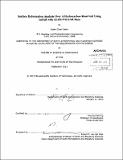| dc.contributor.advisor | Thomas Herring. | en_US |
| dc.contributor.author | Şahin, Sedar Cihan | en_US |
| dc.contributor.other | Massachusetts Institute of Technology. Department of Earth, Atmospheric, and Planetary Sciences. | en_US |
| dc.date.accessioned | 2013-06-17T19:54:13Z | |
| dc.date.available | 2013-06-17T19:54:13Z | |
| dc.date.copyright | 2013 | en_US |
| dc.date.issued | 2013 | en_US |
| dc.identifier.uri | http://hdl.handle.net/1721.1/79299 | |
| dc.description | Thesis (S.M. in Geophysics)--Massachusetts Institute of Technology, Dept. of Earth, Atmospheric, and Planetary Sciences, 2013. | en_US |
| dc.description | Cataloged from PDF version of thesis. | en_US |
| dc.description | Includes bibliographical references (p. 92-97). | en_US |
| dc.description.abstract | InSAR has been developed to estimate the temporal change on the surface of Earth by combining multiple SAR images acquired over the same area at different times. In the last two decades, in addition to conventional InSAR, numerous multiple acquisition InSAR techniques have been introduced, including permanent scatterer (PS) (Ferretti et al., 2001) and small baseline subset (SBAS) (Berardino et al., 2002). Stanford method for persistent scatterers (StaMPS) (Hooper, 2006) is another multiple acquisition method that has been developed for estimating ground deformation and differs from the permanent scatterer technique through the method used for pixel selection. In this project, we used the SBAS method to detect the surface deformation over a hydrocarbon reservoir in Adiyaman Providence, Turkey. The SBAS technique is performed on combinations of SAR images that are characterized by small orbital distances with large time intervals. By applying singular value decomposition (SVD), the temporal sampling rate is increased and those subsets are connected. We applied the SBAS method to five ALOS-PALSAR fine-beam dual (FBD) mode images, and removed the topographic phase by using a 3 arc-sec SRTM digital elevation model (DEM). The atmospheric artifacts are determined and filtered out based on available spatial and temporal information on processed data. Our analysis has revealed that due to the effective mitigation measures taken by the oil company, the maximum observed LOS displacement velocity in the oil field is 5 mm/yr with a likely uncertainty of a similar magnitude in the period of 2007-2010. The high uncertainty estimate is due to the other spatially correlated signals of similar and larger magnitude seen in regions outside of the oil field. | en_US |
| dc.description.statementofresponsibility | by Sedar Cihan Sahin. | en_US |
| dc.format.extent | 97 p. | en_US |
| dc.language.iso | eng | en_US |
| dc.publisher | Massachusetts Institute of Technology | en_US |
| dc.rights | M.I.T. theses are protected by
copyright. They may be viewed from this source for any purpose, but
reproduction or distribution in any format is prohibited without written
permission. See provided URL for inquiries about permission. | en_US |
| dc.rights.uri | http://dspace.mit.edu/handle/1721.1/7582 | en_US |
| dc.subject | Earth, Atmospheric, and Planetary Sciences. | en_US |
| dc.title | Surface deformation analysis over a hydrocarbon reservoir using InSAR with ALOS-PALSAR data | en_US |
| dc.title.alternative | Surface deformation analysis over a hydrocarbon reservoir using Interferometric Synthetic Aperture Radar with Advanced Land Observing Satellite-Phased Array type L-band Synthetic Aperture Radar data | en_US |
| dc.type | Thesis | en_US |
| dc.description.degree | S.M.in Geophysics | en_US |
| dc.contributor.department | Massachusetts Institute of Technology. Department of Earth, Atmospheric, and Planetary Sciences | |
| dc.identifier.oclc | 847522084 | en_US |
